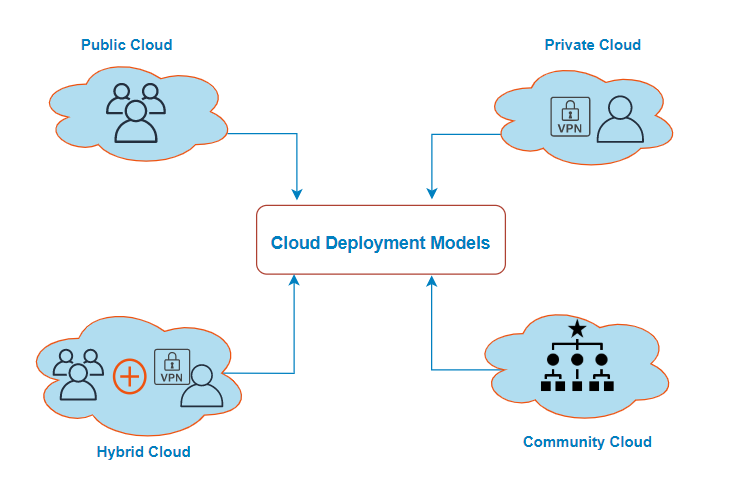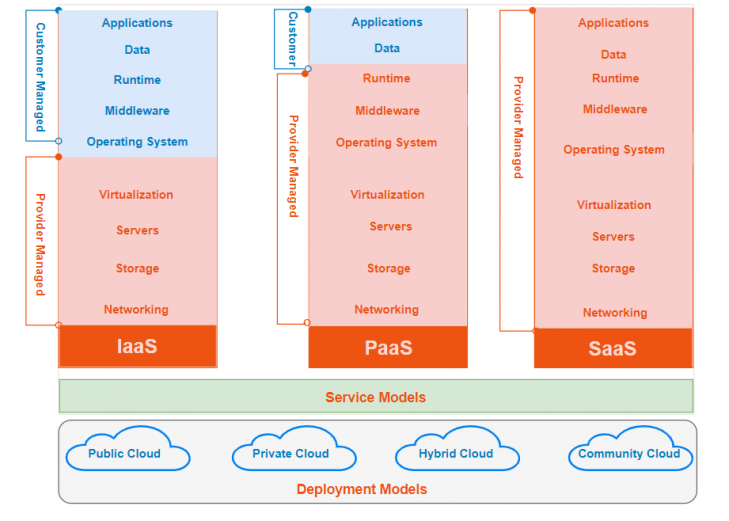Types Of Cloud Computing
Cloud computing can be separated into two types: Deployment Model and Service Model.
Cloud Deployment Model
Cloud deployment models are a configuration of environment to declare how the cloud services are available to users. The deployment model can be separated by some parameters such as ownership, size of infrastructure, who can control the infrastructure, and where infrastructure exists.
There are four most common cloud deployment models are public cloud, private cloud, hybrid, and community cloud.

- Public Cloud: Public clouds are available for all users who want to use infrastructures such as computing resources (Amazon Ec2), Storage, database services, etc. on a pay-per-use or subscription basis. User or organization do not need to buy and maintain hardware instead cloud providers maintain the infrastructure.
Mostly public cloud deployment model is used for businesses where privacy is not a major concern or non-mission critical tasks. Public cloud uses the multi-tenancy model, which also allows users to scale resources when required. - Private Cloud: Private cloud is more expensive than public cloud, but it allows better control on security and privacy of organizations. Private cloud provides the same benefits of public cloud, the difference is that allocated cloud infrastructure is dedicated to only one tenant/organization. Infrastructure resource is not shared with other organizations. Private cloud can be managed on on-premise by organization itself or it can be managed by a cloud service provider.
- Hybrid Cloud: It is a combination of public and private cloud. For example, An organization can manage its mission-critical workloads on a secure private cloud and deploy less sensitive/secure ones to public cloud. This scenario provides a very good balance between security, scalability, Cost.
- Community Cloud: A community deployment model is almost same as a private cloud but the difference is sharing data between organizations. In community cloud organizations who belong to same backgrounds share the infrastructure, resources, and data. For example, the government of a country can have multiple organizations internally, but they need to share some common data.
Cloud Service Model
Cloud service model is mainly divided into three types: Infrastructure as a Service (IAAS), Platform as a Service (PAAS), and Software as a Service (SAAS). Selection of right service model depends on your requirement.

- Infrastructure-as-a-Service (IaaS): Infrastructure as a Service model: Cloud service provider allows virtual provision of your infrastructure components (such as networking hardware, server, storage, etc.). They also provide maintenance and support for the provisioned hardware infrastructure while your business needs to maintain the operating systems, system and security updates, storage, and deployed applications. The IaaS model provides a lot of flexibility to control, manage and customize your infrastructure as per the requirement.
- Platform-as-a-Service (PaaS): Cloud service providers deliver a set of resources such as hardware, servers, storage, networking, etc. which are required for application development. As hardware and software are hosted by the service provider, they are managing the hardware and software updates. Users only need to access the platform to start their work. PAAS is based on subscription, which means pricing/billing is depending on a per-user or monthly basis.
- Software-as-a-Service (SaaS): Software as a Service model: SAAS model allows quick access to your business using internet with zero installation, User only needs a web browser to access cloud-based web applications. This type of application runs on vendor’s cloud also they control the entire computing platform. Some Well-known SAAS examples are Netflix, Instagram, Microsoft Office 365, LinkedIn, etc.
Understanding Types of Cloud Computing: A Practical Overview
